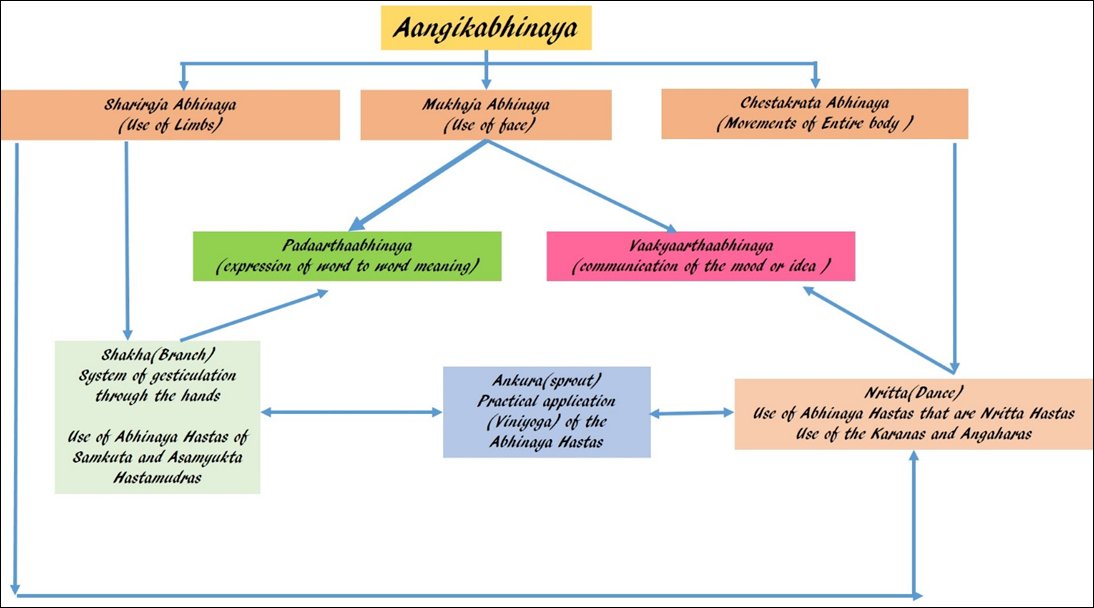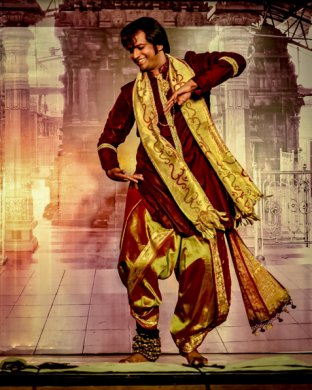
|
 |

|
 |
Influence of Bharata's 'Tandavalakshanam' on Kathak 'Taalpaksh' - Sunil Sunkara e-mail: sunilrsunkara@gmail.com July 13, 2019 Abstract In the journey of evolution of any species, there are certain intrinsic elements that withstand the test of time. Evolved from the earlier apes and bonobos, the Neanderthal man evolved into the homo sapiens, the homo sapiens sapiens and so on. But at one point in this process the species was no longer that of 'ape' but that of a 'human'. This same lens has been applied in this essay while looking at the connection between Natyashastra and Kathak Prayoga. While the movement vocabulary of the Natyashastra as described in the Tandavalakshanam classifies as margi, all the movement vocabulary in Kathak today would classify as desi. That withstanding, this essay bases itself on the belief that there have been certain connecting principles that connects with the very ethos or internal fabric of dance and its creation. It is with this perspective that the influence of Bharata's Tandavalakshanam principles have been looked at in perspective of the taalpaksh in Kathak. Introduction The chapter IV of Bharata's Natyashastra, Tandavalakshanam deals with the cadence of movements, the karanas and longer sequences built upon them, the angaharas. None of the descriptions can be understood without the aid of Chapters VIII, IX and X which deals with the micro and micro movements of the body - in short, all that Bharata recognizes as the larger rubric of Aangikabhinaya [Vatsyayan, 1996]. Rechaka Angahaara Cha Pindibandhah Tatha Ava Cha Shrushriva Bhagvat Dattah Tandave Munaye Tada Tena Aapi Hi Tatahsamyak Gaan Bhand Samanvitah Nrityaprayogah Shrushti Ya Sa Tandava Iti Smrutah Trans: In this way Bhagwan (Lord Shankar) created the rechakas, angaharas and pindibandhas and gave them to sage Tandu. Then Tandu used song and rhythmic instruments to create a form of dance called the Tandav [Ghosh, 2006; Purecha and Gokarnkar, 2016] Tandavalakshanam in the context of Aangikabhinaya Aangikabhinaya is the art of physical expression. The entire human body has been analysed in the Natyashastra as Angas (major limbs) and Pratyangas (minor limbs), based on kinetic principles. Physical expression is a part of human nature and the connection between the psych and the physic is so intrinsic, that even the minutest vibration of the mind gets easily reflected through the body in daily life itself. Hence, the art of physical expression is beautifully conceived, classified and codified by Bharata to artistically suit a dramatic representation. While the concept of beauty is a matter of opinion, these opinions gets crystallized due to a habituation over several centuries and result in giving a specific national character. In Indian ethos, the concept of beauty depends on the law of symmetry, which Bharata elaborates as 'Soushtava' [Subrahmanyam, 1979] Fig 1.looks at the interconnection of the aspects of Aangikabhinaya with respect to Padaarthaabhinaya and Vakyaarthabhinaya, in which we see the use of Karanas, Angaharas, etc.  Concept of the Karana and its application A combination of Sthanas (postures of the body), Nritta Hastas (course of movements of the arms and hands) and Charis (the specific way of moving the leg) are the Karanas, or the unit of Nritta. It is a movement and not a mere pose as normally misunderstood. 'Karana' has its root in 'Krn' meaning doer, causer, doing, making, producing, helping the act of doing and on the whole any action. The word Karana also suggests the idea of being an instrument, an element, an Anga or parts of something. For example, 'Antahkarana' means the inner part or conscience, again popular usage like 'Manasa Vacha Karmanahatvidha Karanaani' meaning by the three aspects of thought, word and deed. Thus Karana is the means to some end. Bharata defines Karanas as 'Hasta Pada Samayogaha Nrityasya Karanam Bhavet' - i.e. the combined movement of hand and foot in dance is called Karana. Abhinavagupta is of the opinion that the words hasta and paada do not literally mean just hand and foot. Hasta implies all actions pertaining to the upper part of the body and Paada denotes all the actions of the lower limbs of the body. Abhinavagupta Further explains that combination of motion and pause is a Karana (Karana: tena gati sthithi sammlitam karanam iti anantyam) [Tripathi, 2014]. Thus the Karana is a unique combination of two paradoxical concepts - Stithi (static) and Gati (dynamic). Thus the Karana involves action in inaction, for which a tremendous sense of balance both physical and mental is necessary. A study of the unique combination of Sthithi and Gati is capable of revealing fundamental truths of universal and individualistic structures as reflected in the concept of Siva and Shakti. The state of action in inaction is what is recommended even in Karmayoga of Bhagavad Gita. Therefore Karanas could be viewed as tangible physical representation of metaphysical and spiritual perceptions [Subrahmanyam, 1979]. The performance of a Karana is of such a short duration that it cannot completely gain the status of a dance sequence. Hence, specified numbers of them are combined to form the Nrittamatrikas (2), Kalaapakas (3), Sandakas (4), Sanghatakas (5), Angahaaras (more than 6) and Pindibandhas. 32 angaharas have been described in the Natyashastra. Each of these are made up of specific Karanas with particularization of the order of their performance. Pindibandhas are group dances which involve the nrittamatrikas and the Angaharas. The matrikas are made up of only 2 Karanas, yet they play an important role in the Pindibandhas. In all of these the beautifying agent is the rechaka. The rechakas are broadly classified as those of the hand, feet, waist and neck and are comparable to gamakas used in music, that is left to the ingenuity and virtuosity of the performer. The actual standard of the dance depends on the rechakas which make a clear line between mere physical exercise and soulful dance with grace. Principles of Tandavalakshanam in Kathak parampara As defined by Jagadekamalla, the song, instrumental music and dance performed according to the tastes of the kings and people in each country is Deshi. According to the Bhatkhande Sangeet Shastra Vol I, all the music and dance forms seen currently are Deshi [Dadheech, 2009]. But the same concept of first creating building blocks like the Karanas and weaving them together is seen in the presentation of various intraforms of the Kathak Taalpaksh. Each gharana uses certain distinct movement patterns as part of its movement vocabulary thus making them identifiable. For example, consider the phrase seen commonly in Aamad, Tathei Tata Thei would be accompanied by the Lavashikha movement of the hands as per the Lucknow tradition [Khare, 2005]. Prayena karane karyo vaamo vaksha stitha kara Charana syanugrachyapi dakshinastu bhavet kare - Natyashastra 4.60 Trans: In the Karana the left hand should generally be held on the chest and the right hand should follow the right foot. This fundamental rule given by Bharata is followed till date in the interweaving of movement sections to create the intraforms of taalpaksh. As mentioned often by Dr. Vibha Dadheech in her lectures on the teaching methodology of Pt Shambhu Maharaj, students were repeatedly told that after each movement has been completed one has to return to the utpatti or kavach position before starting the next movement segment. Again movements always begin from the right in paramparik bandishes, to be followed by a mirroring on the left side.  Depiction of Jalabhramari as a part of Parmelu In regards to the use of the Tandav dance, Bharata muni says, 'Prayena Tandav Vidhi Devastuti Ashraya Bhavet' - the use of tandav should be done in veneration of the gods. This rule is followed in the presentation of Dhrupad in Kathak, which has been pioneered by Dr. Puru Dadheech. In conclusion, in the words of Dr. Manomohan Ghosh, in his translation of Tandavalakshanam, 'Dance is occasioned by no specific need, it has come into use simply because it creates beauty. As dance is naturally loved by almost all people, it is eulogized as being auspicious. It is eulogized also as being the source of amusement on occasions of marriage, child-birth, reception of a son-in-law, general festivity and attainment of prosperity.' Kathak in its journey has been a part of the fabric of daily lives, which is the reason that it spread over a wider geographical reach, in the medieval period in India. As mentioned in the Pothy Prakash of the Awadh Kathak Parampara, the true Natwari Nritya follows the Vidhi or rules of Tandav Nritya and the Bhaav of the Lasya Nritya, thus defining Kathak as freedom within a bound framework. Bhuvi Bharat Mein Hari Nache, Natwar Nartan Laas Sohi Mein Nachat Rahyo, Brij Mein Hari Ke Paas Tandav Vidhikilaya Bhari, Lasya Angke Bhaav Natwar Nartan Naam Dhari, Nachahu Sahaj Swabhaav - Pothy Prakash, 18 CE References Dadheech, Puru, 'Nritya Nibandh', Bindu Prakashan, 2009 Ghosh MM, 'Natyashastra of Bharatmuni -Text, commentary of Abhinava Bharati by Abhinavaguptacharya and English Translation Vol I', New Bharatiya Book Corporation, 2006 Purecha Sandhya Veersingh and Gokarnkar Shrihari Vasudev, 'Bharatmunirachit Natyashastram Khand Pahila', Maharashtra Rajya Sahitya Aani Sanskrutik Mandal, 2016 Subrahmanyam Padma, 'Bharata's Art -Then and Now', Bhulabhai Memorial Institute, 1979 Tripathi Radhavallabh, 'Natyashastra in the Modern World', Rashtriya Sanskrit Sansthan, 2014 A chemical engineer who has pursued his doctorate in biofuel research, Sunil Sunkara holds a masters degree in Kathak from Bharata College of Fine Arts and Culture, Mumbai, and Nritya Nipun from Bhatkhande Sangit Vidyapith, Lucknow. He performs regularly as well as pursues research in Kathak apart from curating dance events and regularly writing on various facets of dance through both print and online medium. Post your comments Please provide your name and email id when you use the Anonymous profile in the blog to post a comment. All appropriate comments posted with name & email id in the blog will also be featured in the site. |